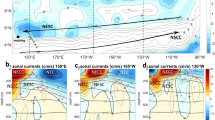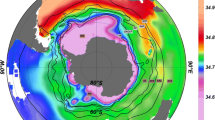Summary
The flow and mass distribution east and southeast of the Lesser Antilles over an area slightly larger than a 10° square are shown with data collected during three seasons. Summer data are associated with the BOMEX project (Barbados Oceanographic and Meteorological Experiment) during the June–August 1969 period. Data collected in January–February 1969 covered a similar station network while the autumn data of September–October 1967 only partially covers the area. The circulation pattern is largely dependent on piling up of water against the Lesser Antilles, which causes isobaric surfaces to slope downward from west to east (6 dynamic centimeters between 59°W and 54°W), while the slope downward from north to south is about twice as large as in the zonal direction. The North Equatorial Current is diverted southward and the back flow resolves in vortex type circulations. The net westward transport between 17°N and Tobago Island was 22×106 m3/s in summer. Also, it has been calculated to be 29×106 m3/s in winter between 18° N and Tobago. The Guiana Current recurves at about 52°–53° W in winter and autumn. As indicated by temperature-oxygen relationship, water to the west of these longitudes is from the southern zone of the North Equatorial Current. The South Atlantic water (Guiana Current) did not intrude into the area in summer. Low salinity surface water moves northwestward approximately 40° to 60° to the right of the mean wind direction and generally to the right of the subsurface geostrophic flow. A large-scale anticyclonic eddy developed between 10°N and the Surinam shelf, and a considerable upwelling has been observed off the coast of Surinam and French Guiana in autumn.
Zusammenfassung
Für ein Gebiet östlich und südöstlich der Kleinen Antillen, das nur wenig größer als ein 10°-Quadrat ist, wird die Bewegung und Verteilung der Wassermassen dargestellt, und zwar anhand von Daten, die im Verlauf von drei Jahreszeiten gesammelt worden sind. Die Sommerdaten entstammen dem BOMEX-Projekt (Barbados Oceanographic and Meteorological Experiment) aus dem Zeitraum Juni–August 1969. Die im Januar–Februar 1969 erfaßten Daten kamen von einem ähnlichen Stationsnetz, während die Herbstdaten von September–Oktober 1967 dieses Gebiet nur teilweise erfassen. Das Zirkulationsmuster ist weitgehend abhängig von dem Anstau von Wassermassen vor den Kleinen Antillen, was bewirkt, daß isobare Flächen von Westen nach Osten abfallen (sechs dynamische Zentimeter zwischen 59° W und 54°W), während der Abfall von Norden nach Süden ungefähr zweimal so groß ist wie in zonaler Richtung. Der Nord-Äquatorial-Strom wird nach Süden abgelenkt und der Rückstrom löst sich in wirbelförmige Zirkulationen auf. Der Netto-Transport nach Westen zwischen 17° N und Tobago Island war 22×106 m3/s im Sommer. Außerdem ist errechnet worden, daß er im Winter 29×106 m3/s zwischen 19° N und Tobago beträgt. Der Guyana-Strom dreht im Winter und Herbst bei ungefähr 52°–53° W wieder um. Wie aus dem Verhältnis Temperatur/Sauerstoff ersichtlich, kommt das Wasser westlich dieser Längen aus dem südlichen Bereich des Nord-Äquatorial-Stromes. Das Wasser des Südatlantik (Guyana-Strom) drang im Sommer nicht in dieses Gebiet ein. Oberflächenwasser mit geringem Salzgehalt bewegt sich nordwestwärts, ungefähr 40–60° rechts von der mittleren Windrichtung und im allgemeinen rechts von der geostrophischen Strömung unter der Oberfläche. Ein großflächiger Hochdruck-Wirbel entwickelte sich zwischen 10° N und dem Surinam-Shelf, und ein beträchtlichesupwelling wurde im Herbst vor der Küste von Surinam und Französisch Guyana beobachtet.
Résumé
On décrit, grâce aux données réunies au cours de trois saisons, l'écoulement et la distribution de la masse des eaux à l'est et au sud des Petites Antilles, sur une étendue un peu plus vaste qu'un carré de 10 degrés. Les données de l'été sont en rapport avec le project BOMEX (Barbados Oceanographic and Meteorological Experiment — Expérience océanographique et météorologique des Barbades) pour la période juin–août 1969. Les données réunies en janvier–février 1969 embrassent un réseau semblable de stations, tandis que celles de l'automne, de septembre à octobre 1967, ne recouvrent qu'une partie de la région. La circulation a un type dépendant beaucoup de l'accumulation des eaux contre les Petites Antilles, ce qui incline les surfaces isobariques vers le bas, d'ouest en est (6 centimètres dynamiques entre 59 et 54 degrés ouest) tandis que la pente vers le bas, du nord au sud est encore deux fois plus forte qu'en direction de la zone. Le courant Nord Equatorial est détourné vers le sud et le contre-courant se transforme en mouvements de type tourbillonnaire. En été, entre le dix septième parallèle nord et l'île de Tabago, 22×106 mètres cubes nets se déplacent chaque seconde vers l'ouest. On a également calculé qu'en hiver 29×106 mètres cubes se déplacent chaque seconde dans cette même région. Le courant de Guyane se recourbe en hiver et en automne par 52–53 degrés ouest environ. Comme l'indique le rapport température-oxygène, les eaux à l'ouest de ces longitudes proviennent de la zone sud du courant Nord Equatorial. Les eaux de l'Atlantique Sud (courant de Guyane) ne s'introduisent pas dans la région en été. Les eaux de surface, de faible salinité, se déplacent vers le nord ouest, à environ 40 à 60 degrés à droite de la direction du vent dominant et, en général, à droite du courant du à la rotation de la terre, circulant sous la surface. On a observé, en automne, un grand tourbillon anticyclonique entre le parallèle 10 degrés nord et le haut fond de Surinam, ainsi qu'un important jaillissement vers le haut, au large de la côte de Surinam et de la Guyane Française.
Similar content being viewed by others
References
Cochrane, J. D., 1963: Equatorial undercurrent and related currents off Brazil in March and April 1963. Science142, No. 3593, p. 669.
Cochrane, J. D., 1965: Equatorial currents of the western Atlantic. Texas A & M Univ., Dep. Oceanogr. & Met., Proj. 286, Ref. 65-17 T, p. 6.
Cochrane, J. D., 1969: Oceanography of the Gulf of Mexico. Texas A & M Univ., Dep. Oceanogr. & Met., Proj., Ref. 69-9T, p. 29.
Data report Equalant I, 1964. Nat. oceanogr. Data Center, Publ. (G-3).
Data report Equalant II, 1964. Nat. oceanogr. Data Center, Publ. (G-5).
Data report Equalant III, 1965. Nat. oceanogr. Data Center, Publ. (G-7).
Defant, A., 1961: Physical oceanography. Vol. 1. Oxford.
Gibbs, R. J., 1970: Circulation in the Amazon River estuary and adjacent Atlantic Ocean. J. mar. Res.28, 113.
Gordon, A. L., 1967: Circulation of the Caribbean Sea. J. geophys. Res.72, 6207.
Helland-Hansen, B., 1934: The Sognefiord Section. Oceanogr. obs. in the Norwegian Sea. In: J. Johnstone Memorial Volume, p. 257. Liverpool.
Mazeika, P. A., 1968: Mean monthly sea surface temperatures and zonal anomalies of the tropical Atlantic. Ser. Atlas mar. Environm.16. Amer. geogr. Soc.
Metcalf, W. G., 1968: Shallow currents along the northeastern coast of South America. J. mar. Res.26, 232.
Metcalf, W. G. and M. C. Stalcup, 1967: Origin of the Atlantic equatorial undercurrent. J. geophys. Res.72, 4959.
Montgomery, R. B., 1938: Circulation in upper layers of southern North Atlantic deduced with use of isentropic analysis. Pap. phys. oceanogr. met.6, No. 2.
Montgomery, R. B. and E. Palmen, 1940: Contribution to the question of the equatorial counter current. J. mar. Res.3, 112.
Neumann, G., 1969: Seasonal salinity variations in the upper strata of the western tropical Atlantic Ocean. 1: Sea surface salinities. Deep-Sea Res.16, 165.
Oltman, R. E., H. O'R. Steinberg, F. C. Ames and L. C. David, 1964: Amazon River investigations reconnaissance measurements of July 1963. Geol. Surv. Circ., Wash. No. 486. 15 pp.
Ryther, J. H., D. W. Menzel and N. Corwin, 1967: Influence of the Amazon River outflow on the ecology of the western tropical Atlantic. Hydrography and nutrient chemistry. J. mar. Res.25, 69.
Stalcup, M. C., W. G. Metcalf and M. Zemanovic, 1971: Current measurements in the lesser Antilles. Techn. Rep. Woods Hole Oceanogr. Instn No. 71-51, 14 pp.
Wattenberg, H., 1938: Die Verteilung des Sauerstoffs und des Phosphats im Atlantischen Ozean. Wiss. Ergebn. Dt. Atlant. Exped. „Meteor” 1925–1927. Bd.9, T. 2.
Williams, R. G., 1966: An investigation of the intermediate salinity maximum in the Equatorial Atlantic during Equalant I. Geophys. Sci. Lab. Rep. No TR-66-4. New York Univ. Dep. Met. Oceanogr.
Wüst, G., 1964: Stratification and circulation in the Antillean-Caribbean Basins. New York.
Wüst, G. und A. Defant, 1936: Schichtung und Zirkulation des Atlantischen Ozeans. Wiss. Ergebn. Dt. Atlant. Exped. „Meteor” 1925–1927. Bd6, T. 1.
Author information
Authors and Affiliations
Rights and permissions
About this article
Cite this article
Mazeika, P.A. Circulation and water masses east of the Lesser Antilles. Deutsche Hydrographische Zeitschrift 26, 49–73 (1973). https://doi.org/10.1007/BF02232264
Received:
Published:
Issue Date:
DOI: https://doi.org/10.1007/BF02232264




